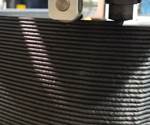VABO Composites to build superstructure, mast for Royal Van Lent yacht
Lightweight marine composites production to be further advanced using robotic automation.
VABO Composites has an exciting contract with the Dutch high-end yacht builder Royal Van Lent to build a more than 800-m2 composite superstructure and mast. Composites, chosen for the topside of this yacht to save weight, will include both glass and carbon fiber as well as resin infusion processing. VABO Composites will be responsible for the concept-engineering, calculations, mold design, mold fabrication and construction of all elements, which will be delivered ready for installation and final painting.
As part of this 12- to 18-month project, VABO Composites will use its new robot on a track for both mold and parts fabrication, with possible thermoplastic 3D printing for some parts of the mold. “We are very proud of this contract with Royal Van Lent and excited to take the next step in our composites production, using robotics on this unique and challenging project,” said VABO Composites president Arnold Vaandrager. “The engineering has already started, and we will keep the industry updated on our progress.”
For more details on VABO Composites and the use of composites in marine superstructures and masts, see “Composite radar masts assembled for megayachts” and “VABO Composites: Dutch innovator excels in diverse applications”.
Related Content
-
Clean Sky 2 outer wing box demonstrator validates OOA LRI, shimless assembly and SHM
Full-scale wing box project achieves TRL 5 with 2% weight reduction and 4% reduction in recurring production costs through improved manufacturing efficiency and assembly processes.
-
Novel insert technology enables arc stud welding with composites
FAUSST technology enables fast, reliably welded connection of metal components in composite structures.
-
Infused sandwich window frame components help double-decker buses meet weight targets
Prototype GFRP parts were evaluated by Spanish bus manufacturer Carrocerías Ayats as an initial move toward lighter, more efficient, more automated parts and processes.



